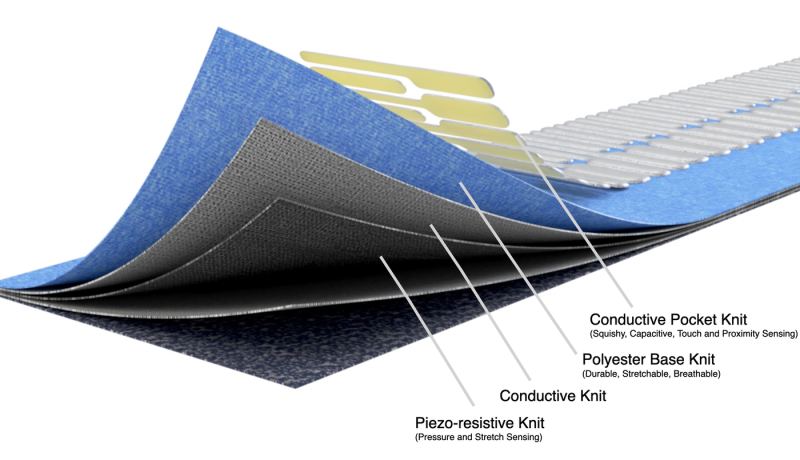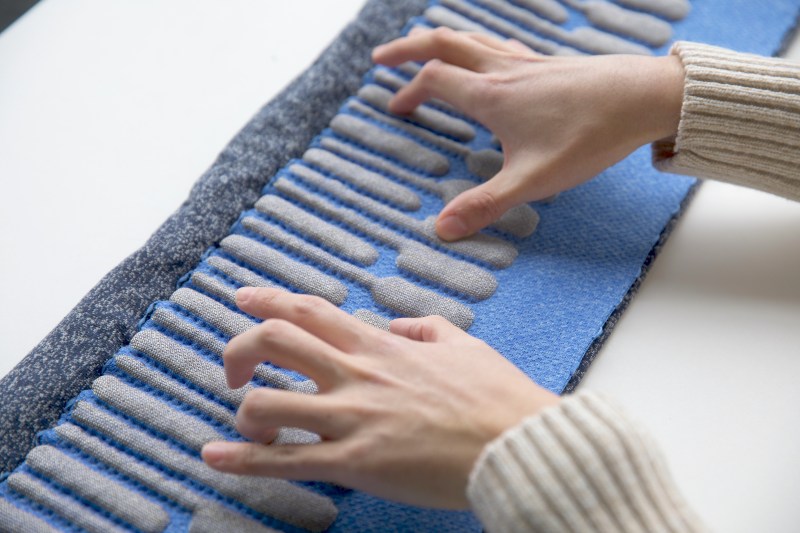There are only so many ways to make noise on standard instruments such as acoustic pianos. Their rigidity and inputs just don’t allow for a super-wide range of expression. On the other hand, if you knit your interface together, the possibilities are nearly endless. MIT’s new and improved knitted keyboard is an instrument like none other — it responds to touch, pressure, and continuous proximity, meaning that you can play it like a keyboard, a theremin, and something that is somewhere in between the two. Because it’s a MIDI interface, it can ultimately sound like any instrument you’ve got available in software.
 The silver keys of this five-octave interface are made of conductive yarn, and the blue background is regular polyester yarn. Underneath that is a conductive knit layer to complete the key circuits, and a piezo-resistive knit layer that responds to pressure and stretch. It runs on a Teensy 4.0 and uses five MPR121 proximity/touch controllers, one per octave.
The silver keys of this five-octave interface are made of conductive yarn, and the blue background is regular polyester yarn. Underneath that is a conductive knit layer to complete the key circuits, and a piezo-resistive knit layer that responds to pressure and stretch. It runs on a Teensy 4.0 and uses five MPR121 proximity/touch controllers, one per octave.
The really exciting thing about this keyboard is its musical (and physical) versatility. As you might expect, the keyboard takes discrete inputs from keystrokes, but it also takes continuous input from hovering and waving via the proximity sensors, and goes even further by taking physical input from squeezing, pulling, stretching, and twisting the conductive yarns that make up the keys. This means it takes aftertouch (pressure applied after initial contact) into account — something that isn’t possible with most regular instruments. And since this keyboard is mostly yarn and fabric, you can roll it up and take it anywhere, or wrap it around your neck for a varied soundscape.
If you’re looking for more detail, check out the paper for the previous version (PDF), which also used thermochromic yarn to show different colors for various modes of play using a heating element. With the new version, [Irmandy Wicaksono] and team sought to improve the sensing modalities, knitted aesthetics, and the overall tactility of the keyboard. We love both versions! Be sure to check it out after the break.
Want to play around with capacitive touch sensors without leaving the house for parts? Make your own from paper and aluminum foil.
















Eat your heart out theremin!
Certainly looks much easier to play – or at least to play to get the specific sound you want…
But there is something awesome about the Theremin…
That’s actually sick im a musician so using keyboards is kinda my thing you made some top tier gadget there well done that should be on the market it reminds me quite a lot of the ROLI seaboard block well done 👍
Kinda looks like this: https://en.wikipedia.org/wiki/ROLI_Seaboard
Would rolling it up, or getting it wet change it’s characteristics over time? Like trying to always hit a moving target with repeatability.
I’d expect some variation with enviroment, but looks to me like it aught to be relatively stable in that environment – so if it gets wet when you turn it on an automatic calibration to the new baseline should mean it just works and plays ‘normally’ to start with but changes as it dries – so probably not a good instrument for a packed indoor concert venue where the humidity etc will change dramatically through the evening…
I don’t think rolling it up will have much effect, I’m very far from an expert on knitted stuff, or those fibres being used for electrical characteristics, but the stability and elasticity created by the knitted pattens in the stuff I have handled suggests it will not be that bothered by it – maybe need to stretch it back into the correct shape every now and then. But I could be very wrong – those fancy conductive fibres might be rather more delicate etc..
Seems like there hasn’t really been an obvious successor to the MPR121. Anyone got any tips for one? I realise that many microcontrollers have a touch peripheral now but I’m not sure there’s anything that’s as low power and easy to implement as the MPR121. Would be glad to be corrected though!